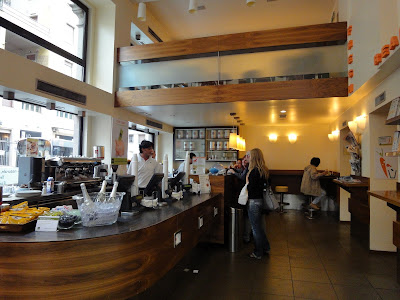Remeber you are now in an extra-territorial region of Austria, so don't expect any typical Italian food while you are in Sudtirol. Instead, be prepared to embrace Southern German cuisines and lots of high-calorie fatty specks.
This is not to say the quality of food available in Sudtirol are bad. It is just that the majority of them are essentially German /Austrian country cuisines. If you love fried pork cutlets (schnitzels), sauerkraut, pickled cucumbers, grilled sausages or potato/bread dumplings, then you are in safe hands.
So, what are the regional specialities of Sudtirol?
1. Knödels with Speck
One of the most famous regional specialities of Sudtirol is the Sudtiroler Speck Alto Adige PGI, a special kind of dry-cured ham whose production is regulated under the protected geogrpahical indication (PGI) status. Unlike other cured hams in Italy, Sudtiroler Speck is manufactured by combining two different meat conservation methods - curing and smoking. Speck is an important ingredient in Sudtirol's cuisines, you will find it everywhere from breakfast to noodles and soups and oven-baked dishes. It also makes good gifts as they can be easily stored if unopened in its original vacuum packaging, and adds that extra creamy, savoury taste to your spaghetti carbonara.
As for knödels, well, they are basically dumplings made with bread, potato, semolina, flour etc. and boiled or poached in water. Usually they serve as side dishes to meat main course but can also be eaten on its own.
One of the most famous regional specialities of Sudtirol is the Sudtiroler Speck Alto Adige PGI, a special kind of dry-cured ham whose production is regulated under the protected geogrpahical indication (PGI) status. Unlike other cured hams in Italy, Sudtiroler Speck is manufactured by combining two different meat conservation methods - curing and smoking. Speck is an important ingredient in Sudtirol's cuisines, you will find it everywhere from breakfast to noodles and soups and oven-baked dishes. It also makes good gifts as they can be easily stored if unopened in its original vacuum packaging, and adds that extra creamy, savoury taste to your spaghetti carbonara.
As for knödels, well, they are basically dumplings made with bread, potato, semolina, flour etc. and boiled or poached in water. Usually they serve as side dishes to meat main course but can also be eaten on its own.
I am not a fan of knödels - as they tend to be too filling, even fatty, for my taste - and certainly not someone who goes to a Paulaner beer garden restaurant while on holidays (I don't even go there while not on holidays). But this is Bozen, and there are not that many places which are still open after 9pm, so I had to make do with Paulaner.
The blue-and-white tiles of the decor ensures a distinctive Bavarian touch to the whole place - Paulaner is from Bavaria and they make sure you are aware of it :)











